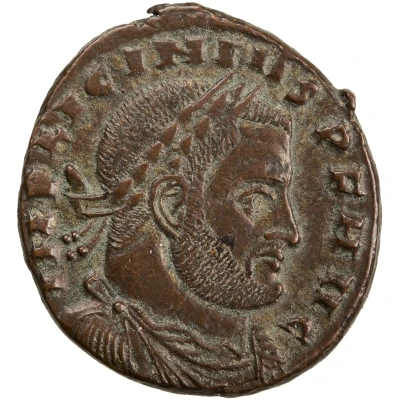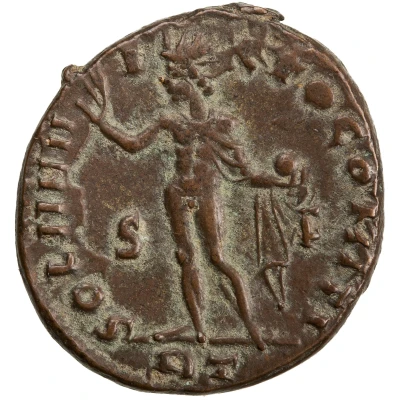


© EPHESE
Nummus - Licinius I IOVI CONSERVATORI AVGG; Alexandria
315 year| Bronze | 3.3 g | 19 mm |
| Issuer | Rome › Roman Empire (27 BC - 395 AD) |
|---|---|
| Emperor | Licinius I (308-324) |
| Type | Standard circulation coin |
| Year | 315 |
| Value | Nummus (1⁄7200) |
| Currency | Solidus, Reform of Constantine (AD 310/324 – 395) |
| Composition | Bronze |
| Weight | 3.3 g |
| Diameter | 19 mm |
| Thickness | 1 mm |
| Shape | Round (irregular) |
| Technique | Hammered |
| Demonetized | Yes |
| Updated | 2024-10-05 |
| Numista | N#119930 |
|---|---|
| Rarity index | 87% |
Reverse
Jupiter standing left, head laureate, chlamydia on left shoulder, holding nephephorus globe in right hand and long scepter in left hand; at his feet, eagle standing left, turning head to right, holding crown in beak; above in right field, crown above Δ itself above Ν.
Script: Latin
Lettering: IOVI CONSERVATORI AVGG
Comment
Licinius I was directly proclaimed Augustus following the Carnuntum conference on November 11, 308. In 313, following the Edict of Milan, he married Constantine's half-sister Constantia. In 316, the first war between Licinius and Constantine ended with the death of Valens and the signing of a peace treaty between the two Augustinians. On April 1, 317, three Caesars were created: Crispus, Constantine II and Licinius II. A second war broke out between Constantine and Licinius in 321, ending with the decisive defeat at Chrysopolis in 324 and the deposition of Licinius, who was exiled to Thessalonica before being executed the following year.Interesting fact
One interesting fact about this coin is that it features an image of the Roman god Jupiter on one side, and the emperor Licinius I on the other. This coin was minted during Licinius' reign as emperor, which lasted from 308 to 324 AD. The image of Jupiter on the coin is significant because it highlights the importance of Roman mythology and religion during this time period. Additionally, the fact that the coin was minted in Alexandria, Egypt, suggests that the Roman Empire had a significant influence on the region and its economy.

